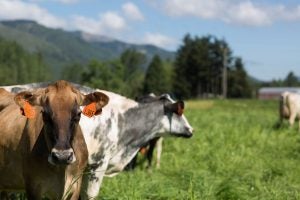Coldstream Farms of Deming, Washington, a family farm in the northwest corner of the state, is working to turn their 2,500-cow dairy into a zero-waste business with a cutting-edge filtration system that will transform the cow manure into clean water.
On average, the cows at Coldstream Farms produce about 60,000 gallons of cow manure a day — 22,000 of which will go through the system’s combination of nanofiltration and reverse osmosis and transform that cow manure into 12,000 gallons of clean water daily. After treatment, the water will be clean enough for the cows to drink, irrigation for the farm’s crops, and even benefit local salmon runs by increasing streamflow. Other products of the system will be approximately 16 yards per day of nutrient-rich solid manure and 8,000 gallons of nitrogen and potassium-rich concentrate, which is suitable for use as fertilizer. These concentrated nutrients will be used by the farm as well as on other local commodities, like berries and potatoes, to replace imported fossil-based fertilizers.
Coldstream Farms will be the first and currently only farm to be using this type of clean water membrane technology in the state. The farm will be able to utilize some of its current manure management technology, the Beddingmaster, to treat the primary solids that come from the 60,000 gallons of manure a day.

Regenis, an agricultural waste solutions company, has been working with the farm to get the system up and running. Eric Powell, Business Development Director with Regenis, approached the dairy in 2017 about the potential of installing this on the farm.
“We knew from the beginning that Coldstream Farms would be a great fit for this technology,” Powell said. “Their location, climate, and size all work really well together to make this technology successful.”
Nutrient management techniques vary significantly across Washington, especially between eastern and western farms. The wetter western climate has its benefits, but when it comes to managing cow manure, it can present a unique set of challenges.
Galen Smith of Coldstream Farms chooses to see the rain as an opportunity to improve the business. “We get anywhere from 80 to 120 inches of rain each year,” Galen explained. “With that much rainfall, we have to get creative. With this system, we’ll have the ability to capture some of this water and put it to good use.”
One of those uses is through a partnership with the Public Utility District (PUD) No. 1 of Whatcom County and the state Department of Ecology to create a convergence between the dairy’s clean water and the nearby Nooksack River.
“The PUD takes pride in protecting resources to benefit the residents, businesses and agricultural community of Whatcom County,” said PUD General Manager, Stephan Jilk. The PUD has worked with the Whatcom County agriculture industry and dairy and berry farmers for years on securing and helping them manage resources to sustain them. “The PUD considers this clean water membrane technology as a sustainable solution to some of the water resource issues we are facing, and we hope to see the technology replicated on other Whatcom County farms.”

Coldstream Farms was awarded a $930,305 grant from the Washington State Conservation Commission to help cover installation, operating costs, and research.
“We are so thankful that the legislature sees the significance in investing in technology for agriculture,” added Galen. “We are very hopeful that the research provided from this project will not only benefit our farm but the state’s agriculture as a whole.”
Why did the farm decide to invest in this technology?
“Well, it’s simple, “Galen stated. “Our goal is to use every resource on our farm and let nothing go to waste. Not only is this system helping us do that, but it’s improving the overall sustainability cycle of local agriculture.”


